Software Application for Automated Evaluation and Selection of a Rational Technological Process †
Abstract
1. Introduction
2. Description of the Developed Web-Based Application for Rational Process Selection
2.1. Application Architecture
- Java Spring Boot—for building the back-end and REST API;
- PostgreSQL—as a relational database for data storage and processing;
- Angular—for creating a dynamic and interactive user interface;
- Docker—for containerization and simplified deployment of the entire system.
2.1.1. User
2.1.2. Front-End
- Data visualization;
- Collecting and validating user input;
- Communicating with the back-end via REST API.
2.1.3. Back-End
- Handling requests from the Angular application;
- Processing business logic;
- Accessing and writing to the PostgreSQL database;
- Sending emails via MailDev;
- Securing resources through robust authentication using JWT [21].
2.1.4. Database
- Relationships between tables (foreign keys);
- Transactions;
- Indexing and query optimization;
- Data types such as JSON for storing flexible data structures.
2.1.5. MailDev
- Sending test emails from the application;
- Visualization of the emails via a web interface;
- Preventing real sending in a test environment.
2.1.6. Docker and Containerization
- Network settings;
- Environment variables;
- Data volumes for persistent storage;
- Service dependencies (e.g., the back-end waits for the database to start).
2.2. Application Interface
- Easy access to key functions—users can quickly navigate to different modules of the application.
- Consistent design—uniform buttons, color schemes, and navigation elements are used to ensure intuitive orientation.
- Responsive design—the web application is optimized for various screen resolutions and devices, enabling access from desktops, tablets, and smartphones.
- Ease of future expansion—the interface structure allows for the seamless integration of new functionalities during future development phases.
2.2.1. Home Page
2.2.2. Parts Page
2.2.3. Page “Part Dashboard”
- Dashboard (pos. 2) provides an overview of the most important information and the main indicators of the system operation. Here, the user can view the selected rational technological process and the more important information about parameters that are essential for the part.
- Technological processes (pos. 3) takes the user to a module that presents the different alternative technological processes for the production of the particular part, as well as allows the possibility of adding new technological processes.
- Criteria (pos. 4) provides access to the input and management of the specific criteria according to which the evaluation and selection of the technological process is carried out.
- Quality Control (pos. 5) offers a quality control module in which users can input information from part measurements, set parameters, monitor metrics, and manage quality, stability, and capability aspects of selected technological processes.
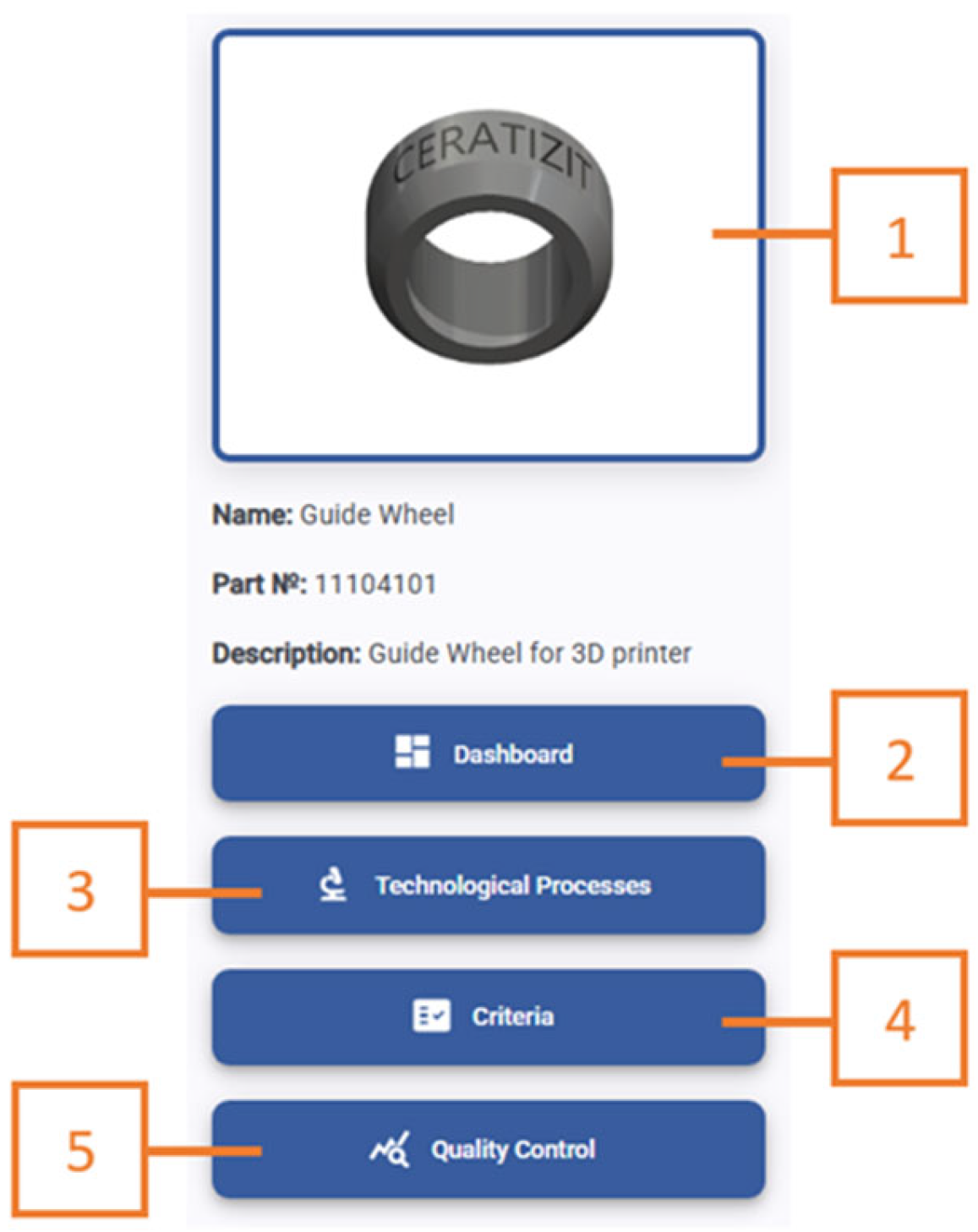
2.2.4. Technological Processes
2.2.5. Criteria
2.2.6. Quality Control
3. Application Validation in Real Manufacturing Conditions
3.1. Selection of the Case Study Object
- The production program of the part provides a sufficient statistical volume of data, which is of utmost importance for the correct conclusion of the evaluation of the different technological processes.
- Availability of dimensional accuracy and roughness requirements, which allows for comparing the results of different technological processes, in the development of which precision is one of the main factors. The specified dimensions and their tolerance ranges, as well as the roughness, allow the use of different measuring instruments without requiring expensive or specialized laboratory facilities. In this way, quality control and evaluation methods remain within the limits of generally accepted manufacturing practices.
- Due to its relatively simple but functional construction, the workpiece allows for the easy application of different technological processes, making it suitable for validating the developed software application.
- The production of this part with different technological solutions provides an opportunity to compare the final cost of the part, the machining time, and the quality parameters.
- Inner diameter accuracy ⌀16+0.018;
- Outer diameter accuracy ⌀24 ± 0.2 mm, according to ISO 2768—m [24];
- Length accuracy 10 ± 0.2 mm, according to ISO 2768—m;
- Roughness of machined surface with required value Ra 0.8;
- Cost per part;
- Production time.
- Digital surface roughness tester—SRT 6210 for measuring the surface roughness (Ra) of the machined surfaces, with measuring range—Ra: 0.005 ÷ 16.00 µm;
- Mitutoyo caliper—graduation: 0.02 mm and range: 0–100 mm;
- ETOPOO digital micrometer for internal diameters—graduation: ±0.002 mm and range: 5–30 mm.
3.2. Results of Measurements
4. Conclusions
- Enhanced user roles and access control, allowing differentiation between various positions within the working environment;
- Capability to store and display detailed design and technological information for each product;
- Tracking of all stages of the product’s lifecycle—from the conceptual design phase to full-scale production implementation;
- Option to generate and print reports based on the analyzed data.
Author Contributions
Funding
Institutional Review Board Statement
Informed Consent Statement
Data Availability Statement
Acknowledgments
Conflicts of Interest
Abbreviations
| IIoT | Industrial Internet of Things |
| CAPP | Computer-aided process planning |
| FUCOM | Full Consistency Method |
| MCDM | Multi-criteria decision-making |
| IT | Information technology |
| REST API | Representational State Transfer Application Programming Interface |
| SQL | Structured Query Language |
| JPA | Java Persistence API |
| JWT | JSON web token |
| JSON | JavaScript Object Notation |
| DNS | Domain Name System |
References
- Zhukov, A.; Bobrova, E.; Popov, I.; Arega, D.B. System analysis of technological processes. Int. J. Comput. Civ. Struct. Eng. 2021, 17, 73–82. [Google Scholar] [CrossRef]
- Tsoneva, Z.; Stoianova, A. Study Feature of Intersecting Elements of the Cylinder Pipe Network. Possibilities for Application of Computer Programs. East. Acad. J. 2016, 1, 89–98. [Google Scholar]
- Tsoneva, Z.; Tachev, M.; Bankova, A.; Parushev, P.; Tenev, S.; Mehmedov, I.; Deneva, P. Descriptive Geometry and Computer Modelling in Support of Planning the Restoration of the Roof Covering of the “Dormition of the Mother of God” Cathedral in Varna. Eng. Proc. 2024, 70, 52. [Google Scholar] [CrossRef]
- Emovon, I.; Oghenenyerovwho, O.S. Application of MCDM Method in Material Selection for Optimal Design: A Review. Results Mater. 2020, 7, 100115. [Google Scholar] [CrossRef]
- Jamwal, A.; Agrawal, R.; Sharma, M.; Kumar, V. Review on Multi-Criteria Decision Analysis in Sustainable Manufacturing Decision Making. Int. J. Sustain. Eng. 2020, 14, 202–225. [Google Scholar] [CrossRef]
- Patel, S.K. A Decision Analysis Model for Gear Material Selection Using MCDM Techniques. Int. J. Sci. Res. Eng. Manag. 2024, 8, 1–5. [Google Scholar] [CrossRef]
- Chatterjee, S.; Chakraborty, S. Material Selection of a Mechanical Component Based on Criteria Relationship Evaluation and MCDM Approach. Mater. Today Proc. 2021, 44, 1621–1626. [Google Scholar] [CrossRef]
- Chakraborty, S.; Jana, T.K.; Paul, S. On the Application of Multi-Criteria Decision Making Technique for Multi-Response Optimization of Metal Cutting Process. Intell. Decis. Technol. 2019, 13, 101–115. [Google Scholar] [CrossRef]
- Chakraborty, S.; Chakraborty, S. A Scoping Review on the Applications of MCDM Techniques for Parametric Optimization of Machining Processes. Arch. Comput. Methods Eng. 2022, 29, 4165–4186. [Google Scholar] [CrossRef]
- Trung, D.D. Multi-Criteria Decision Making under the MARCOS Method and the Weighting Methods: Applied to Milling, Grinding and Turning Processes. Manuf. Rev. 2022, 9, 3. [Google Scholar] [CrossRef]
- Hagag, A.M.; Yousef, L.S.; Abdelmaguid, T.F. Multi-Criteria Decision-Making for Machine Selection in Manufacturing and Construction: Recent Trends. Mathematics 2023, 11, 631. [Google Scholar] [CrossRef]
- Alqoud, A.; Milisavljevic-Syed, J.; Salonitis, K. Multi-Criteria Decision Making in Evaluating Digital Retrofitting Solutions: Utilising AHP and TOPSIS. Procedia CIRP 2025, 132, 184–190. [Google Scholar] [CrossRef]
- Pamučar, D.; Stević, Ž.; Sremac, S. A New Model for Determining Weight Coefficients of Criteria in MCDM Models: Full Consistency Method (FUCOM). Symmetry 2018, 10, 393. [Google Scholar] [CrossRef]
- Peneva, T. Development of an Algorithm for Application for Automated Selection of a Rational Technological Process. Mater. Res. Proc. 2024, 46, 322–329. [Google Scholar] [CrossRef]
- Moreb, M. Design and Implementation of Software Engineering for Modern Web Applications; Advances in Systems Analysis, Software Engineering, and High Performance Computing; IGI Global Scientific Publishing: Hershey, PA, USA, 2024. [Google Scholar] [CrossRef]
- Dhalla, H.K. A Performance Comparison of RESTful Applications Implemented in Spring Boot Java and MS.NET Core. J. Phys. Conf. Ser. 2021, 1933, 012041. [Google Scholar] [CrossRef]
- Rufino, J.; Alam, M.; Ferreira, J.; Rehman, A.; Tsang, K.F. Orchestration of Containerized Microservices for IIoT Using Docker. In Proceedings of the 2017 IEEE International Conference on Industrial Technology (ICIT), Toronto, ON, Canada, 22–25 March 2017; pp. 1532–1536. [Google Scholar] [CrossRef]
- Jaramillo, D.; Nguyen, D.V.; Smart, R. Leveraging microservices architecture by using Docker technology. In Proceedings of the SoutheastCon, Norfolk, VA, USA, 30 March–3 April 2016; pp. 1–5. [Google Scholar] [CrossRef]
- Piastou, M. Comprehensive Performance and Scalability Assessment of Front-End Frameworks: React, Angular, and Vue.js. World J. Adv. Eng. Technol. Sci. 2023, 9, 366–376. [Google Scholar] [CrossRef]
- Wyciślik, Ł.; Latusik, Ł.; Kamińska, A.M. A Comparative Assessment of JVM Frameworks to Develop Microservices. Appl. Sci. 2023, 13, 1343. [Google Scholar] [CrossRef]
- Nardone, M.; Scarioni, C. JSON Web Token (JWT) Authentication. In Pro Spring Security; Apress: Berkeley, CA, USA, 2024. [Google Scholar] [CrossRef]
- Salunke, S.V.; Ouda, A. A Performance Benchmark for the PostgreSQL and MySQL Databases. Future Internet 2024, 16, 382. [Google Scholar] [CrossRef]
- Choudhary, A. Learning Advanced Docker Concepts. In When Docker Meets Java; Apress: Berkeley, CA, USA, 2025. [Google Scholar] [CrossRef]
- ISO 2768-1; General Tolerances—Part 1: Tolerances for Linear and Angular Dimensions Without Individual Tolerance Indications. ISO: Geneva, Switzerland, 1989.

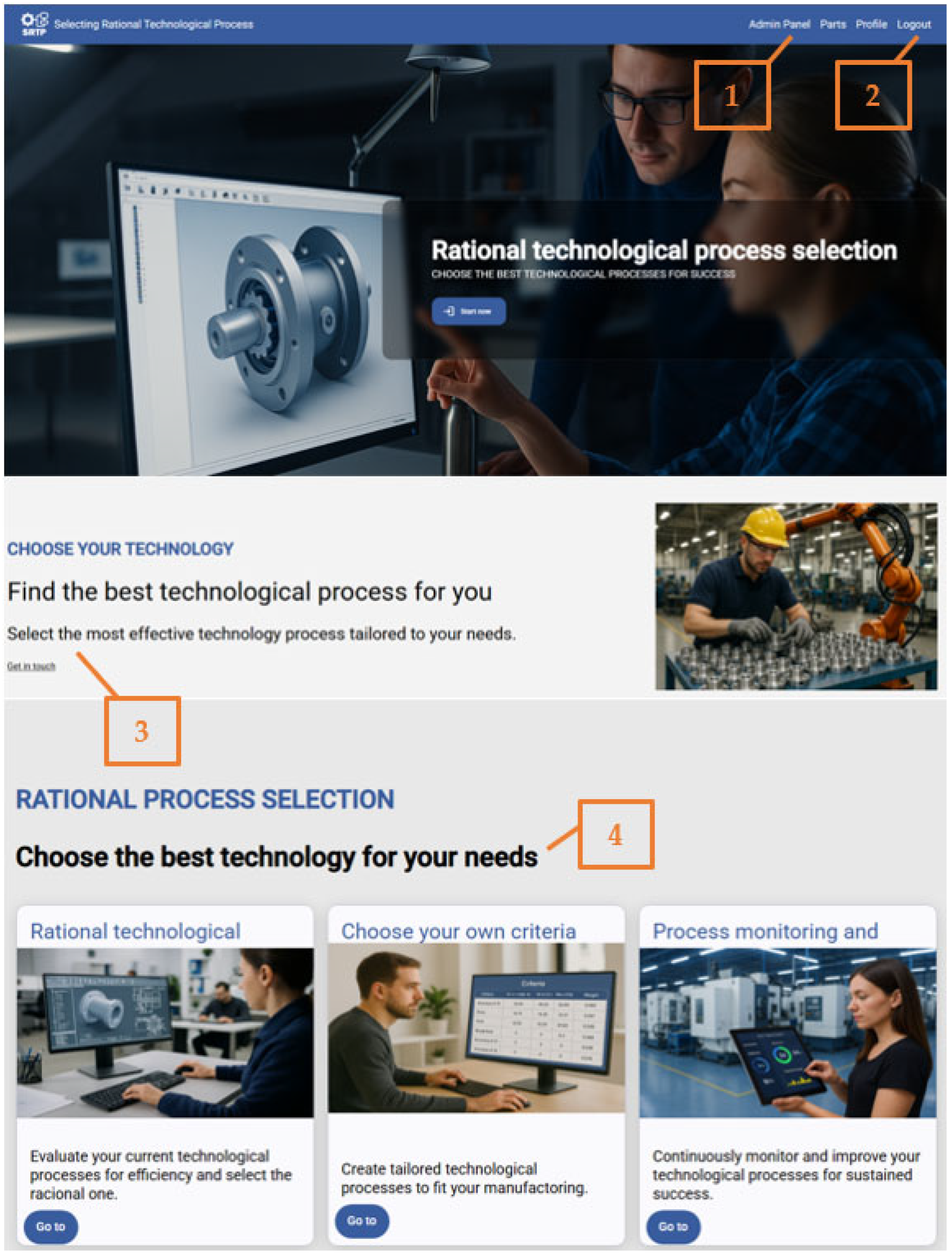



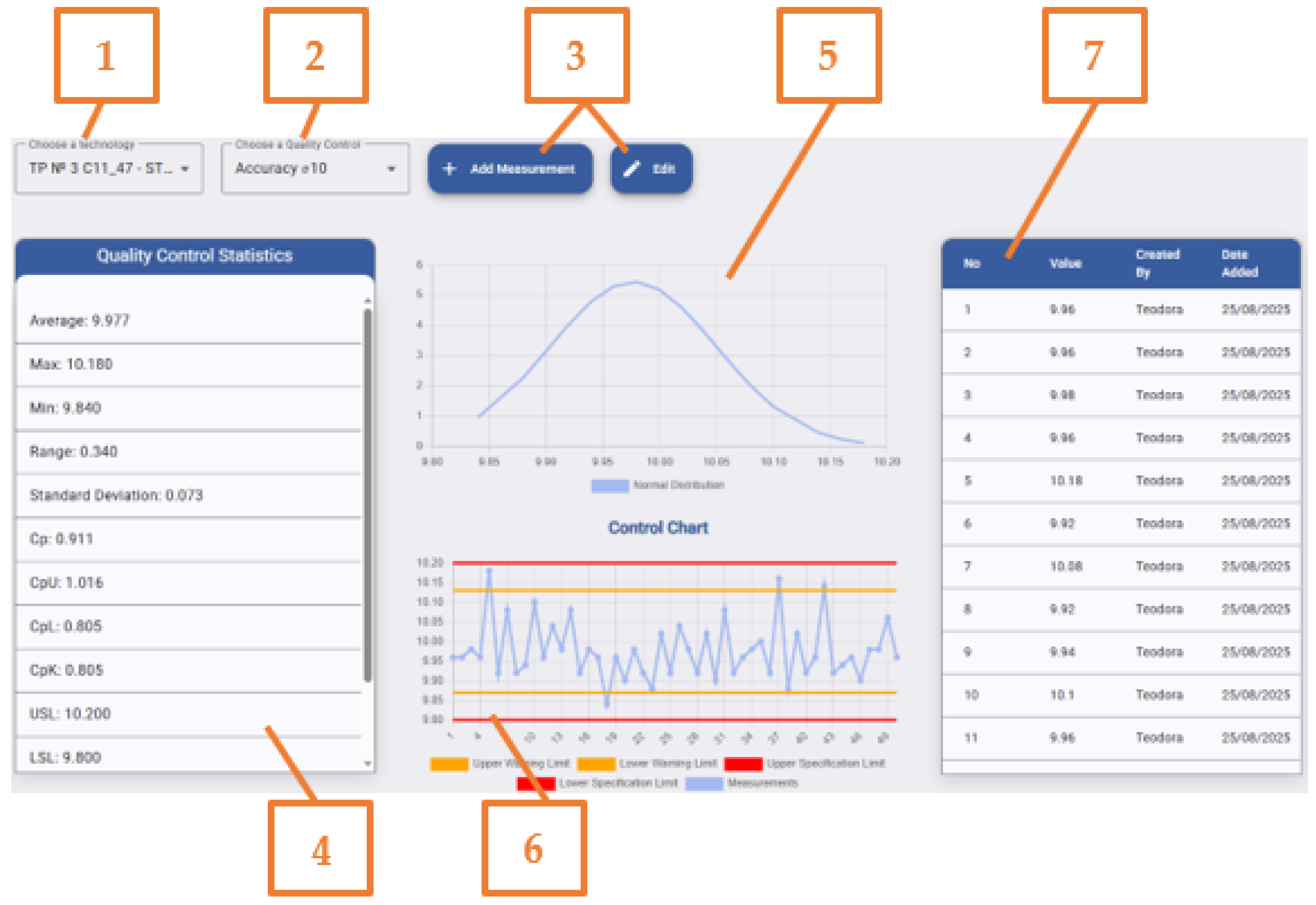

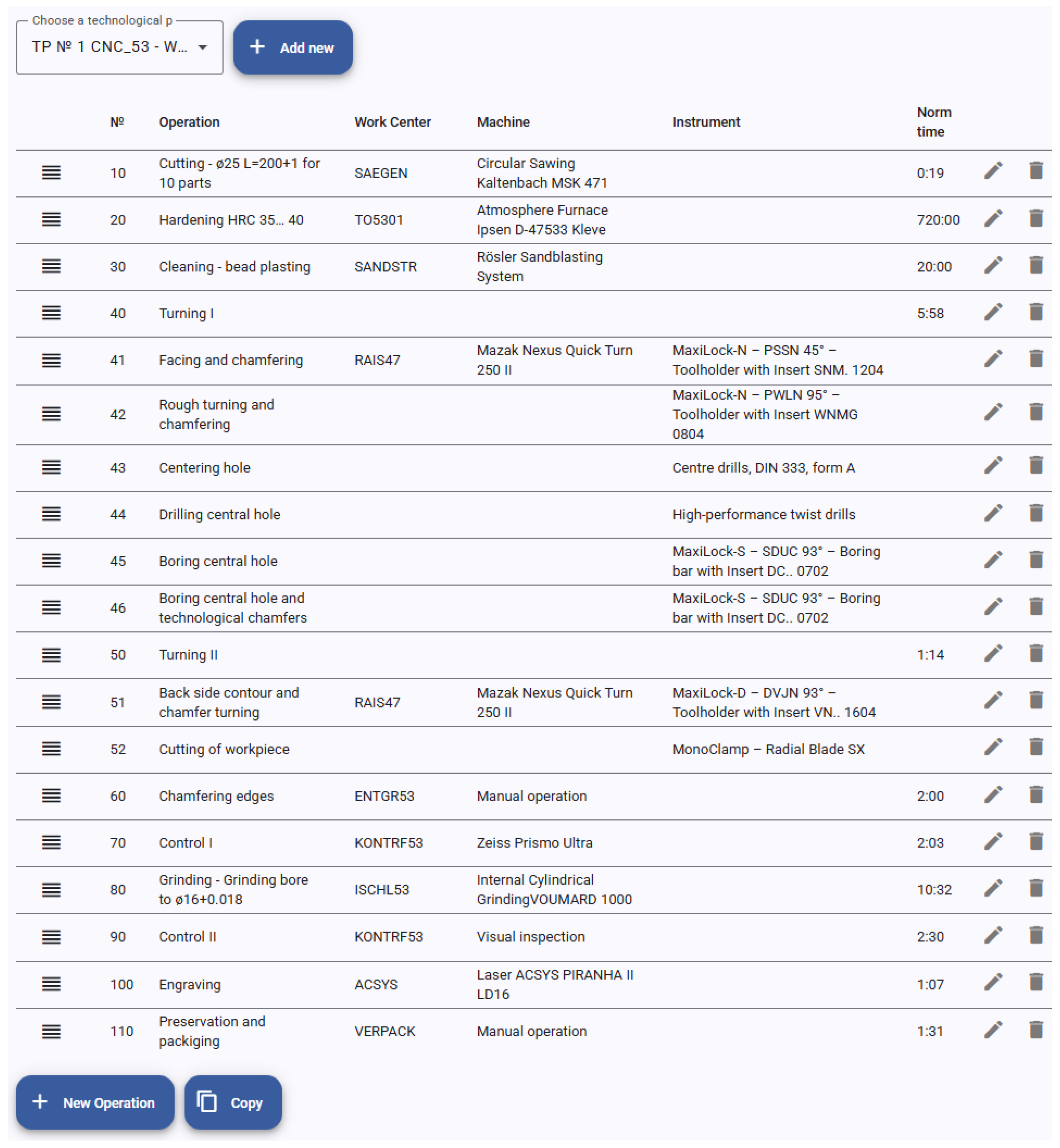
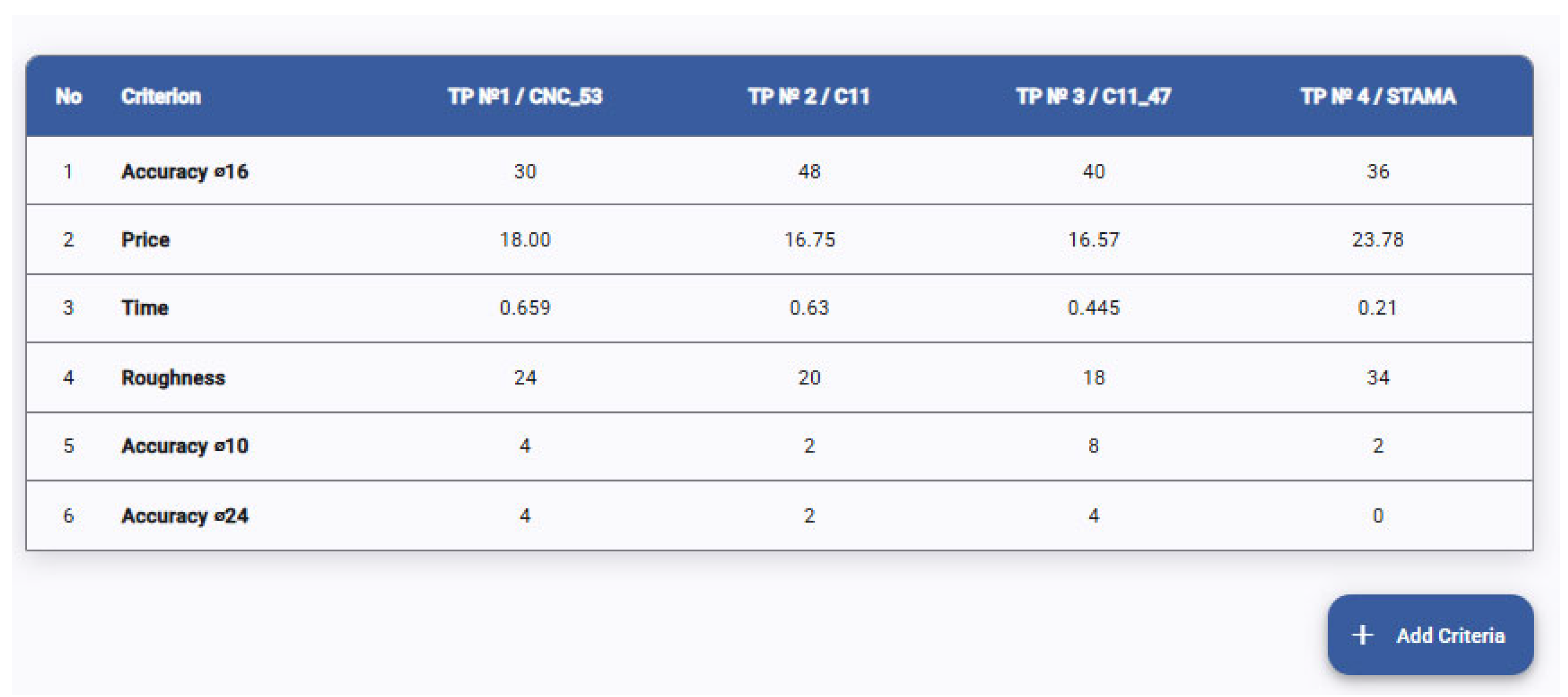


Disclaimer/Publisher’s Note: The statements, opinions and data contained in all publications are solely those of the individual author(s) and contributor(s) and not of MDPI and/or the editor(s). MDPI and/or the editor(s) disclaim responsibility for any injury to people or property resulting from any ideas, methods, instructions or products referred to in the content. |
© 2025 by the authors. Licensee MDPI, Basel, Switzerland. This article is an open access article distributed under the terms and conditions of the Creative Commons Attribution (CC BY) license (https://creativecommons.org/licenses/by/4.0/).
Share and Cite
Peneva, T.; Avramova, T.; Georgiev, P. Software Application for Automated Evaluation and Selection of a Rational Technological Process. Eng. Proc. 2025, 104, 71. https://doi.org/10.3390/engproc2025104071
Peneva T, Avramova T, Georgiev P. Software Application for Automated Evaluation and Selection of a Rational Technological Process. Engineering Proceedings. 2025; 104(1):71. https://doi.org/10.3390/engproc2025104071
Chicago/Turabian StylePeneva, Teodora, Tanya Avramova, and Plamen Georgiev. 2025. "Software Application for Automated Evaluation and Selection of a Rational Technological Process" Engineering Proceedings 104, no. 1: 71. https://doi.org/10.3390/engproc2025104071
APA StylePeneva, T., Avramova, T., & Georgiev, P. (2025). Software Application for Automated Evaluation and Selection of a Rational Technological Process. Engineering Proceedings, 104(1), 71. https://doi.org/10.3390/engproc2025104071






